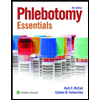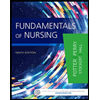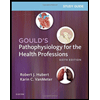
Concept explainers
To describe: The pathophysiology, etiology, manifestations, diagnostic tests, and treatment for iron-deficiency, pernicious, aplastic, sickle cell, and thalassemia with their comparisons.
Concept introduction: Blood is a fluid connective tissue that carries oxygen, glucose, and nutrients throughout the body. Anemia is a condition in which the total number of red blood cells in the blood circulation is reduced, or there is a decrease in the quality or quantity of hemoglobin. Different types of anemia are different in their causes and treatments.
Explanation of Solution
Iron-deficiency anemia:
Pathophysiology: Iron-deficiency anemia (IDA) is the most common type of anemia that occurs due to lack of iron. Inadequate iron impairs the synthesis of hemoglobin and thus reduces the amount of oxygen transported through the blood. Due to depleted levels of hemoglobin, iron ions that are stored in the bone marrow are also used to maintain an adequate hemoglobin production, and fewer iron ions are recycled. A decreased hemoglobin production leads to insufficient iron supply and restricts the synthesis of hemoglobin. Thus, it causes iron-deficiency anemia.
Etiology: Deficit in iron can occur for several reasons as follows:
- 1. Chronic blood loss within the body from a hiatal hernia, a peptic ulcer, or a colon polyp can cause IDA. Even a small amount of continuous blood loss can lead to IDA. This is because this condition can lead to a decrease in the number of red blood cells, which in turn depletes hemoglobin from the body.
- 2. The acid-producing cells in the stomach called parietal cells release intrinsic factor (IF). IF binds to Vitamin B12 and prevent the destruction of this vitamin from hydrochloric acid (secreted by the parietal cell). Vitamin B12 is important for the production of red blood cells. A decrease in the number of red blood cells can lead to IDA.
- 3. Inadequate iron intake can also cause IDA.
- 4. Severe liver disease also affects the absorption and storage of iron.
Manifestations: The manifestations of IDA are as follows:
- 1. Delayed healing
- 2. Brittle hairs
- 3. Concave and ridged nails
- 4. Stomatitis and glossitis
- 5. Heart palpitations
- 6. Dyspnea
- 7. Tachycardia
- 8. Irritability
- 9. Fatigue
- 10. Cold intolerance
- 11. Lethargy
- 12. Shortness of breath
- 13. Pale skin
- 14. Menstrual irregularities
Diagnostic tests: Laboratory tests indicate low counts of hemoglobin and hematocrit. The microscopic examination shows that erythrocytes are appeared as hypochromic and macrocytic.
Treatment: The treatment of IDA depends on its cause. Iron-rich foods or iron supplements in the form of absorbable may be administered.
Pernicious anemia:
Pathophysiology: Pernicious anemia (PA) is the most common type of macrocytic anemia that is caused due to the deficit of Vitamin B12 (cyanocobalamin). Pernicious means highly destructive or injurious. Vitamin B12 plays an important role in the formation of red blood cells (RBC). This is because a deficit in this vitamin can inhibit the thymidylate and purine synthesis; impair the synthesis of deoxyribonucleic acid and apoptosis of erythroblast during the process of erythropoiesis. As red blood cells are the carriers of the hemoglobin (gives red color to the RBC and supply oxygen throughout the body), a decrease in the count of RBC also decreases the amount of hemoglobin.
Etiology:
- 1. Malabsorption of Vitamin B12 can cause pernicious anemia.
- 2. It may develop from chronic gastric.
Manifestations: The manifestations of pernicious anemia are as follows:
- 1. Enlarged tongue
- 2. Nausea and vomiting
- 3. Paresthesia
- 4. Loss of muscle coordination
- 5. Chest pain
- 6. Weakness
- 7. Headaches
Diagnostic tests: The microscopic observation shows macrocytic or megaloblatsic appearance of erythrocytes. The counts of erythrocytes are reduced in the peripheral blood. Serum Vitamin B12 level is below normal. Granulocytes are hypersegmented with decreased number. The presence of gastric atrophy is confirmed by the presence of hypochlorhydria or achlorhydria.
Treatment: The treatments for the pernicious anemia are as follows:
- 1. Oral supplements are recommended.
- 2. Vitamin B12 injection as well as replacement therapy is used to treat pernicious anemia.
Aplastic anemia:
Pathophysiology: Aplastic anemia is a condition that occurs due to damage of the bone marrow and results in the loss of stem cells and pancytopenia. This decreases the count of leukocytes, erythrocytes, and platelets in the blood, that is, all the cells differentiate from the bone marrow.
Etiology: Depending upon the cause, aplastic anemia may be permanent or temporary. The etiology of this condition is as follows:
- 1. It may be caused by viruses, particularly by hepatitis C.
- 2. Systemic lupus erythematosus (SLE) may affect the bone marrow.
- 3. The bone may be affected by myelodysplastic syndrome.
- 4. Exposure to toxic chemicals, such as insecticides, and pesticide and industrial chemicals, such as benzene may damage bone marrow and cause aplastic anemia.
Manifestations: The manifestations of aplastic anemia are as follows:
- 1. Weakness
- 2. Dyspnea
- 3. Pale skin
- 4. Skin rash
- 5. Frequent infection
- 6. Excessive bleeding
- 7. Easy bruising
- 8. Tachycardia
- 9. Thrombocytopenia
Diagnostic tests: Red blood cells are normal in appearance. A bone marrow test is required to confirm. Blood counts indicate deficit of all three cellular components, such as red blood cells, white blood cells, and platelets.
Treatment: The treatments for the aplastic anemia are as follows:
- 1. Bone transplantation is required to recover bone marrow.
- 2. Blood transfusion may be required if levels of stem cells are very low.
- 3. Chemotherapy and radiation are also used before the transplantations of bone marrow.
- 4. Some medication, such as cyclosporine, and anti-theymocyte globulin are used to suppress the function of immune cells that damage the bone marrow.
Sickle-cell anemia:
Pathophysiology: Sickle cell anemia is a genetic condition of the red blood cells, wherein the shape of the red blood cells become sickle shaped. They cannot carry adequate oxygen to different parts of the body. It is caused due to the mutation in the gene, which is necessary for the production of hemoglobin. Sickle cell anemia leads to the formation of hemoglobin S (abnormal hemoglobin), wherein an amino acid in the pair of beta-globin chains changed into valine from the normal glutamic acid. This altered hemoglobin becomes deoxygenated, crystallizes, and changes the shape of red blood cells into sickle shape.
Etiology: Sickle cell anemia is caused by single point mutation in hemoglobin-beta gene (HBB) that is present in chromosome 11. The muted gene passes from one generation to next generation in a pattern of inheritance (autosomal recessive inheritance).
Manifestations: Sickle cell anemia shows signs from the early conditions that are as follows:
- Frequent infection
- Pain in chest, arms, or legs
- Jaundice
- Fussiness
- Fatigue
- Paleness
- Chest pain
- Rapid heart rate
- Splenomegaly
- Recurrent infection
- Vascular occlusion
- Congestive heart failure
Diagnostic tests: Hemoglobin electrophoresis helps to detect the carriers of the defective gene.
Treatment: The treatments for the sickle cell anemia are as follows:
Hydroxyurea is used to reduce the frequency of crisis and to prolong the life span.
Dietary supplements with folic acid are recommended.
Bone marrow transplantation is effective.
Thalassemia:
Pathophysiology: Thalassemia is an inherited blood disorder that is characterized by abnormal form of hemoglobin. These types of anemia result when one or more genes are variant or missing that are responsible for the synthesis of hemoglobin. Hemoglobin is normally made up of four globin chains, namely two α-chains and two β-chains. The abnormality in gene for hemoglobin interferes with the production of globin chains. As a result, the accumulation of other available chains damages the red blood cells and causes thalassemia.
Etiology: Thalassemia alpha is caused due to mutation in the α-chains and is more commonly found in those of Chinese, Indian, and southeast Asian descent. Thalassemia beta is caused due to mutation in the β-chains and is more commonly found in people from Mediterranean countries such as Italy and Greece.
Manifestations: The manifestations of thalassemia are as follows:
- 1. Fatigue
- 2. Weakness
- 3. Pale skin
- 4. Facial bone deformities
- 5. Dark urine
- 6. Abdominal swelling
- 7. Slow growth and development
- 8. Heart failure
Diagnostic tests: The blood tests indicate elevated levels of erythropoietin and low levels of hemoglobin (hypochromic). An iron overload often exists. Prenatal diagnosis can also be done by chorionic villus assay.
Treatment: The treatments for thalassemia are as follows:
- 1. Blood transfusions are the only treatment to treat thalassemia.
- 2. Folate acids administration is also recommended.
- 3. In some children, bone marrow transplants have been used.
The pathophysiology, etiology, manifestations, diagnostic tests, and treatment for iron-deficiency, pernicious, aplastic, sickle cell, and thalassemia are compared in the table below:
| Criteria | Iron-deficiency anemia | Pernicious anemia | Aplastic anemia | Sickle cell anemia | Thalassemia |
| Pathophysiology | A decreased hemoglobin production leads to insufficient iron supply and restricts the synthesis of hemoglobin. | A deficit in this vitamin can inhibit the formation of red blood cells. | It occurs due to damage of the bone marrow and results in loss of stem cells and pancytopenia that decrease the counts of blood cells. | The hemoglobin S becomes deoxygenated, crystallizes, and changes the shape of red blood cells into sickle shape. | It results when one or more genes are variant or missing that are responsible for the synthesis of hemoglobin. |
| Etiology |
|
|
| Single point mutation in hemoglobin-beta gene (HBB) that present in chromosome 11. | Mutation in the α-chains and β-chain |
| Manifestations |
|
|
|
|
|
| Diagnostic tests |
|
| Blood counts indicate deficit of all three cellular components | Hemoglobin electrophoresis helps to detect the carriers of the defective gene | Elevated levels of erythropoietin and low levels of hemoglobin |
| Treatments | Iron-rich foods or iron supplements in the form of absorbable may be administered. | Vitamin B12 injection as well as replacement therapy is used to treat pernicious anemia. | Bone transplantation and blood transfusion | Dietary supplements with folic acid and bone marrow transplantation | Blood transformation and folate acids administration |
Want to see more full solutions like this?
Chapter 10 Solutions
Gould's Pathophysiology for the Health Professions, 6e
- overview of the neurological system, cranial nerves and what part of the body it innervatesarrow_forwarddifferentiate structure and function of the peripheral vascular system. what are the normal and abnormal findings of the peripheral arterioles and peripheral venous systemarrow_forwardAn overview of the skin, hair and nails epidermal appendages normal and abnormal findingsarrow_forward
- differentiate the twelve cranial nerves and how to test themarrow_forwardWhat are the nursing interventions for patients with GI problems ? What is the priority ?arrow_forwardAdult Nutrition Assessment Date of consultation: 3/2/25 Reason for Nutrition Assessment: Mrs. Clover was referred to the RD from the ER physician; patient experiencing weight loss, SOB & Edema Nutrition Assessment Data 69 YOF Ht 157 cm, Wt 53 kg. BMI 21.7 Usual wt 55 kg Heart: slight physiologic murmur; lungs: clear; extremities: 3+ edema to bilateral lower legs; elevated BP, abdomen: soft, nontender, active bowel sounds; neurologic: unremarkable; skin: diminished skin tugor. Biochemical Data BUN 72, Creatinine 4.6, Calcium 7.2, Phosphorus 7.3, glucose 105, BNP 720, Albumin 2.0, Na 125, K 3.3, CI 93. Hgb 11.5, Hct 33.2, ALT 29, AST 36, Alkaline phosphatase 120, other relevant labs pending result. Medications Include inhalers, Cymbalta, Neurontin, Seroquel, and topiramate, prilosec, solumedrol, rocephin, zithromax, NaCl 0.45%+50 MEQ sodium bicarbonate @100 ml/hr. No history of herbal supplements. Since her pneumonia diagnosis several days ago, she has felt too weak to prepare meals, she…arrow_forward
- Assuming you are a community health nurse, choose a community of your own and perform practically the following and report your findings: a. Community Assessment b. Community Diagnosisarrow_forwardDescribe practically how you would use a standing order in the diagnosis and treatment of a 10-year-old primary school pupil with a complaint of haematuria at the end of the urine.arrow_forwardSimple explanations, please. B. Why is an accurate diagnosis of malnutrition important? H. Is BMI a food indicator of malnutrition? I. Can an overweight/obese patient develop malnutrition? Why or why not?arrow_forward
- How is the severity of malnutrition determined based off the table? Simple explanation please.arrow_forwardDiscuss on: 1. Peptic Ulcer disease Aetiology 2. Classification of drugs used in the treatment of PUD 3. Triple therapy of PUD 4. Drugs Contraindicated in PUDarrow_forwardCATH LAB FUNDAMENTALS I WORKSHEET #2 Patient #1 NAME: AO 232/112 M CaO2 ml/L LV 232/25 CvO2 ml/L RA M 17 C.O. L/Min RV 61/17 S.V. ml/beat PA 61/25 M C.I. L/Min/M2 PAW M 25 S.I. ml/beat/M2 Hgb 10.3 S.V.R Dynes/sec/cm5 Hct % T.P.R Dynes/sec/cm5 PA Sat 56% P.V.R Dynes/sec/cm5 AO Sat 81% BSA M2 HR 113 BPM 02 Cons. 233 ml/min Ht _5_ft_10_in Wt. _330_lbs Patient#2 AO 78/46 M CaO2 ml/L LV 78/10 CvO2 ml/L RA M---7 C.O. L/Min RV 21/7 S.V. ml/beat PA 21/12 M C.I. L/Min/M2 PAW M- 12- S.I. S.V.R ml/beat/M2 Dynes/sec/cm5 Hct 45%…arrow_forward
 Phlebotomy EssentialsNursingISBN:9781451194524Author:Ruth McCall, Cathee M. Tankersley MT(ASCP)Publisher:JONES+BARTLETT PUBLISHERS, INC.
Phlebotomy EssentialsNursingISBN:9781451194524Author:Ruth McCall, Cathee M. Tankersley MT(ASCP)Publisher:JONES+BARTLETT PUBLISHERS, INC. Gould's Pathophysiology for the Health Profession...NursingISBN:9780323414425Author:Robert J Hubert BSPublisher:Saunders
Gould's Pathophysiology for the Health Profession...NursingISBN:9780323414425Author:Robert J Hubert BSPublisher:Saunders Fundamentals Of NursingNursingISBN:9781496362179Author:Taylor, Carol (carol R.), LYNN, Pamela (pamela Barbara), Bartlett, Jennifer L.Publisher:Wolters Kluwer,
Fundamentals Of NursingNursingISBN:9781496362179Author:Taylor, Carol (carol R.), LYNN, Pamela (pamela Barbara), Bartlett, Jennifer L.Publisher:Wolters Kluwer, Fundamentals of Nursing, 9eNursingISBN:9780323327404Author:Patricia A. Potter RN MSN PhD FAAN, Anne Griffin Perry RN EdD FAAN, Patricia Stockert RN BSN MS PhD, Amy Hall RN BSN MS PhD CNEPublisher:Elsevier Science
Fundamentals of Nursing, 9eNursingISBN:9780323327404Author:Patricia A. Potter RN MSN PhD FAAN, Anne Griffin Perry RN EdD FAAN, Patricia Stockert RN BSN MS PhD, Amy Hall RN BSN MS PhD CNEPublisher:Elsevier Science Study Guide for Gould's Pathophysiology for the H...NursingISBN:9780323414142Author:Hubert BS, Robert J; VanMeter PhD, Karin C.Publisher:Saunders
Study Guide for Gould's Pathophysiology for the H...NursingISBN:9780323414142Author:Hubert BS, Robert J; VanMeter PhD, Karin C.Publisher:Saunders Issues and Ethics in the Helping Professions (Min...NursingISBN:9781337406291Author:Gerald Corey, Marianne Schneider Corey, Cindy CoreyPublisher:Cengage Learning
Issues and Ethics in the Helping Professions (Min...NursingISBN:9781337406291Author:Gerald Corey, Marianne Schneider Corey, Cindy CoreyPublisher:Cengage Learning





